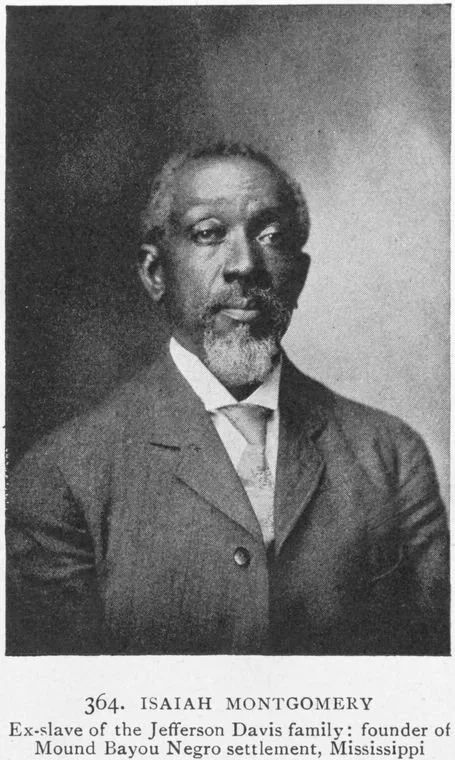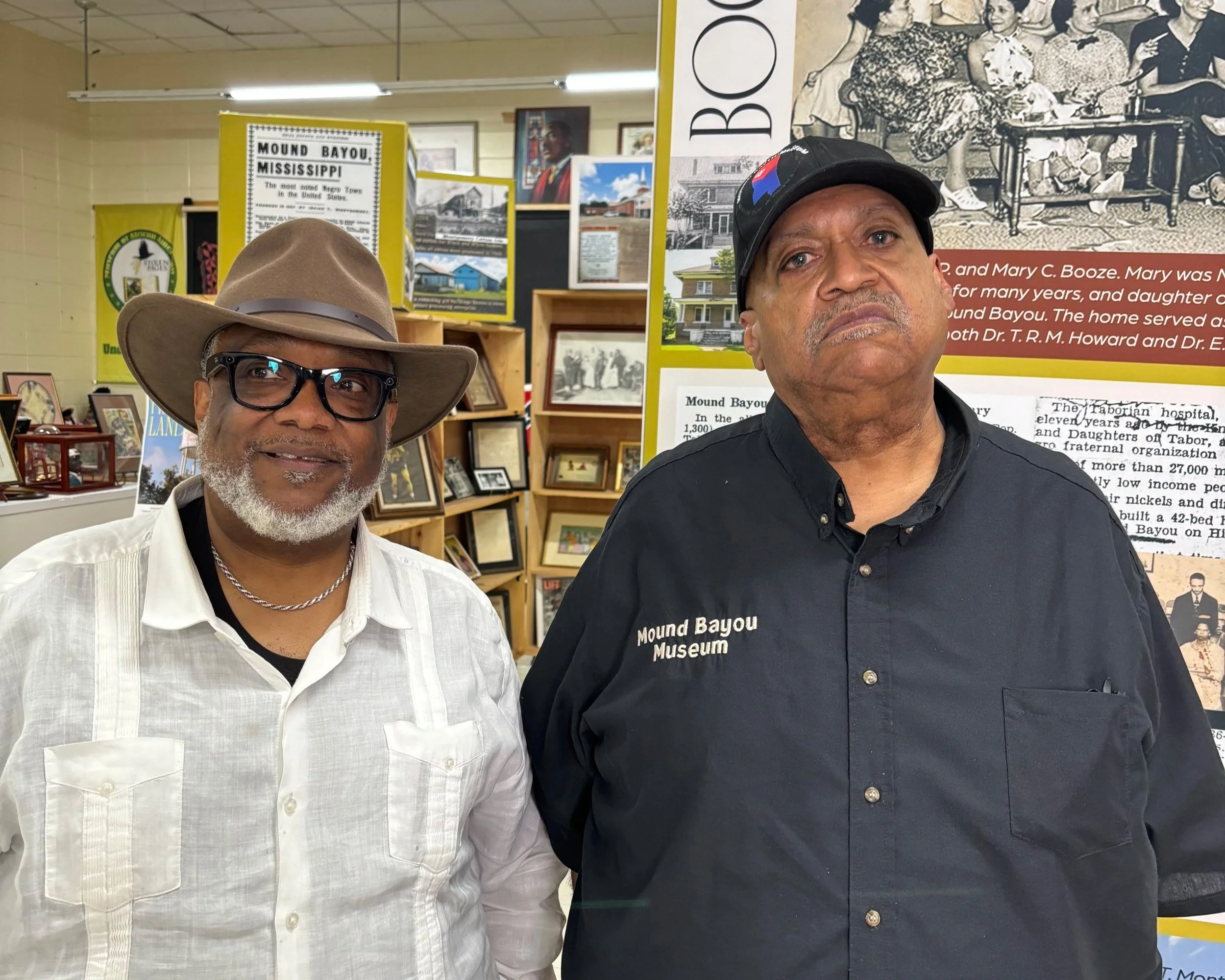(S1E2) A Promised Land: Mound Bayou Museum of Culture and History
“How does Mound Bayou’s legacy continue to shape a model of Black self-determination?”
About Mound Bayou
Mound Bayou, Mississippi—founded in 1887 by formerly enslaved visionaries Isaiah T. Montgomery and Benjamin T. Green—is the oldest all-Black municipality in the United States. Their new settlement thrived so impressively that in 1902 President Theodore Roosevelt, passing through on a bear-hunt train, “gave a speech out there, and he remarked on the level of progress and prosperity in Mound Bayou,” before exclaiming, “This is the Jewel of the Delta—it was the most remarkable place he had seen on his travels,” says Hermon. Laughing, Darryl Johnson delights in sharing Roosevelt’s final observation: “And these are 100 percent Negroes”—a testament to a community defined by its uncompromised Black identity.
The Johnsons trace their roots to Mound Bayou’s earliest settlers. Darryl explains, “Mom and dad were born in Mound Bayou,” just like his great-grandmother Ada Simmons and her husband Samuel Thompson, whose families intermarried and laid down deep local ties. Around 1911, Ada Simmons founded the all-women’s Renovator Society to rally residents around the town’s anniversary: “She was the president, and they decided every July 12th we celebrate the founding of Mound Bayou. And today . . . we do the same thing again. We’ve been doing it every year since then.”
A Museum Born from Void and Faith
“We had nothing. Actually, almost how God created the world - it was void. We had nothing, but in our hearts, we had a story. And I really believe that the pull and the force that got us involved were greater than what you could see. That force is a call of God for us to identify who we are and identify and show people who we are.”
Museum Co-Founders
Darryl Johnson (left) and Hermon Johnson Jr. (right)
Museum Co-Founder Darryl Johnson on the silences on Mound Bayou’s history he experienced in childhood.
Darryl recalls growing up surrounded by civil-rights figures—his father, Hermon Johnson Sr. (celebrating his 96th birthday on May 5, 2025), hosted Medgar Evers and John Lewis, and family friend Fannie Lou Hamer—yet the textbooks stayed silent. “I knew some things when I was going to school and found out that they gave me a Mississippi history book in ninth grade that had nothing about Mound Bayou,” he says. “To me,” he observes, “that says they don't want to tell our story, and it was purposely. They gave me a book in Mound Bayou that didn't have Mound Bayou. So, I knew that the truth had a power.”
By 2021, Darryl and his brother Hermon Jr. had secured a building on Roosevelt Street, right in the heart of town. On July 10—in advance of the community’s 134th anniversary—they opened the Mound Bayou Museum of African-American Culture and History, driven by the belief that only descendants could faithfully preserve their legacy.
Hermon frames their mission in spiritual terms as a continuation of Montgomery’s vision. “It goes back to when I.T. Montgomery came to Mound Bayou,” he remarks. “He kind of considered himself God-led…as sort of like a Moses, bringing people to Mound Bayou through all the troubles they were having. So…hearing some of this…gave a bigger value to what we had to do here in Mound Bayou.” Darryl adds, “For them, Mound Bayou was a promised land. For me, Mound Bayou is a promised land that I can see spiritually…that energy that comes from our Mound Bayou and that energy that comes from us putting this museum together is all wrapped up within that greater call that we as a people must make it to this promised land.”
Acquiring a $3 Million Collection
Turning vision into reality in rural Mississippi demanded faith. Their leap was rewarded when Dr. Alvin Simpson, custodian of a vast collection of Black-history artifacts, rejected a $3 million offer and pledged his archive to the fledgling museum. “Dr. Simpson had decided before we had a museum,” Darryl relates. “When he [Hermon] called Dr. Simpson, I think the bottom line was he found out that Dr. Simpson had a made-up mind: ‘My collection is going to Mound Bayou.’ “He turned the three-million dollars down.”
Women of the Movement and Till (2022) Exhibit
“I’m behind the last part of the class and I hear one girl say to the other one “This - in Mississippi?” She couldn’t believe what she saw in Mississippi, and I took out of that that they don’t expect this value to be here. They don’t expect something uplifting like that to be here, or something as definitely costly, to be here in Mississippi, and it told me the value of what we’re doing. Just hearing that comment from them.”
Soon after the museum’s opening, the museum got an unexpected call from a Women of the Movement (2022) crew member—herself born in Mound Bayou—offering to donate the series’ props once production wrapped. “Sure,” Hermon recalls saying. “I never heard of that before. Didn't know anything about that.” A few weeks later, crates of costumes, décor, and set pieces arrived.
Museum Co-Founder Hermon Johnson Jr. on the museums impact on children.
At first, the Till. producers considered sending the heavy set to Mound Bayou too costly. But just two or three weeks before the film’s wide release, they changed course and sent a small advance team before the premiere. Their arrival made the story bigger: a handful of news outlets turned up, curious to see how Hollywood artifacts fit alongside the grassroots museum’s collection. Touring the galleries, they encountered the “Women of the Movement” set tucked into the back room. “I think it opened up their understanding of what kind of place this was,” Hermon recalls. Back in Los Angeles, conversations resumed—and the producers decided to ship over a box of additional props, knowing the museum already held one of the series’ costumes. Soon, the studio called again: they would build the exhibit themselves. Darryl laughs, “We didn’t even have time to buy a mannequin. We didn’t even know how to buy a mannequin.”
Women of the Movement and Till Exhibit
Today, that Hollywood momentum lives on in a dual showcase of genuine civil-rights treasures and on-screen memorabilia. In the Emmett Till & Mamie Till-Mobley Exhibit, original courtroom photos, newspaper clippings, and the very items Mamie carried while sheltered by Dr. T.R.M. Howard during the 1955 trial share space with set pieces and her costume props from the 2022 film Till. Nearby, the Women of the Movement Props Gallery transforms a vividly painted room with salvaged New Orleans sound-stage décor and the dresses, hats, and coats worn by actresses portraying Mamie Till-Mobley, Fannie Lou Hamer, and Dorothy Height— mannequins and interactive displays drawing you into their strategies, sacrifices, and beliefs.
Honoring Delta Medical Legacies
Taborian Hospital
Mound Bayou’s medical legacy draws healthcare professionals and history buffs alike. In 1942, the Knights and Daughters of Tabor opened Taborian Hospital—the nation’s first HMO (Health Maintenance Organization)—equipped with operating rooms, X-ray, incubators, EKG, a blood bank, and a lab, funded by community dues and staffed entirely by Black doctors and nurses. Under Dr. T.R.M. Howard, it mentored activists like Medgar Evers and Fannie Lou Hamer and hosted Regional Council of Negro Leadership rallies with Thurgood Marshall and Mahalia Jackson. Though federal takeover led to its 1983 closure, its spirit of self-determination endures.
Delta Health Center
In November 1967, the Delta Health Center opened in a converted parsonage with War on Poverty funds, offering primary care, dental, pharmacy, and maternal-child services alongside pioneering sanitation and “food prescription” programs, as the nation’s first rural community health clinic. As founding physician Dr. Robert Smith said, it became “the conduit for physicians…who believed that all people have a right to health care.” “Those two things are powerful,” Hermon Johnson Jr. reflects. “Either one by itself, but for both of them to be here is really valuable…A lot of doctors come to do studies, and people who are in school to be doctors—this is like a Mecca for them. So, they come from Boston and Chicago and other places just to come down here.” Today’s clinic–museum co-tours showcase Mound Bayou’s community-rooted model of equitable healthcare, still relevant in today’s fight for access.
A Town Saved by a Caravan of Hope
If their story seems miraculous, it echoes a nearly forgotten chapter of 1982: facing bankruptcy after a costly white supremacist-backed lawsuit, Mound Bayou appealed WDIA in Memphis, Tennessee—the nation’s first Black-run radio station—for help. Station manager Charles “Chuck” Scruggs launched the “Caravan of Hope,” rallying listeners across the South to fill a mile-long procession of cars with donations. The drive raised about $120,000—enough to clear the town’s debts and ensure its survival, heralded by The New York Times as a “miraculous rescue.” Today, the Caravan of Hope survives in local lore—and soon a feature-length documentary—as a testament to resilience, self-help, and the power of collective action and Black-owned media.
Hermon Johnson Jr. states: “So many people came that day and to bring money down here and come there and be a part of that rally and they saved Mound Bayou….and I think because people understood in Memphis...Mound Bayou was their rest haven. They can come here and sit down and take their shoes off and not worry about a cop following them and oppressing them, and so those people weren't gonna let that happen…Mound Bayou was saved by our people…The seed of Mound Bayou from I.T. Montgomery…his dream…it wasn’t in the cards for them to smother.”
Dreaming a Future: Preservation, Expansion, and the Spirit of Mound Bayou
As they look to the future, the brothers juggle two priorities: preserve what they’ve built and lay the groundwork for growth. Darryl underscores the urgent need for a new roof to shield rain-leaking galleries and irreplaceable artifacts. They envision new wings—one honoring Dr. T.R.M. Howard, another tracing Mound Bayou’s cotton heritage, and a dedicated Emmett Till exhibit through a local lens. “We could utilize 10 times the space that we have,” Hermon says. “We have enough that's displayed here in this museum for probably three to four museums, just with what we have in here in this room…There's much more that's necessary to tell the story.”
When asked about Mound Bayou’s future, Darryl offers: “I have a dream. I see us moving further into this. But because there’s an incompletion of the vision that Isiah T. Montgomery and Benjamin Green had. There has to be a connection to that vision, and a satisfaction to the call… I think until that happens in Mound Bayou—for us to do our part to make that happen—then we won’t be satisfied. So we’ll continue. I continue because of my incompleteness…I’ll never be satisfied until I’m satisfied…And I’m not satisfied until I see a completeness of the vision that I have.”
Rooted in nearly 140 years of Black self-determination, Darryl and Hermon—two brothers whose roots run as deep as the Delta soil—keep that unfinished vision firmly in view.
Follow and Support the Mound Bayou Museum
Website: https://www.moundbayoumuseum.org/
Email: mounbayoumusuem@gmail.org
IG: https://www.instagram.com/moundbayoumuseum/
Youtube: https://www.youtube.com/channel/UCgIuTN5Rw84Mu6G3Ac_T-vw
FB: https://www.facebook.com/theofficialmbmuseum/
































